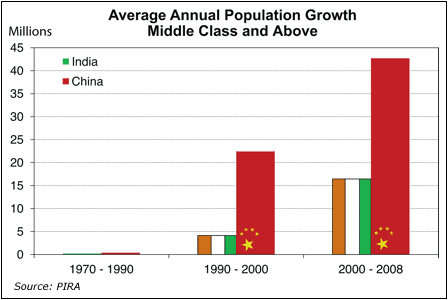|
|||
The Case for Commodities in 2010 (And Beyond)By Frank Holmes The biggest emerging economies have ambitious plans that require a greater share of the world's limited commodities. This trend is spurring profound and permanent disruptions in how these resources are allocated now and in the future. For investors, these disruptions present opportunities. Simply put, an investment in natural resources is a vote of confidence in global economic growth. Rapid urbanization and industrialization, better infrastructure and growing consumption in emerging markets are among the key themes in the global growth story. They are also key drivers in the rising demand for oil, steel, copper, cement and other resources. Here are just a few of the many available data points to help gauge the scale of opportunity:
Commodities (as measured by the Reuters-Jefferies CRB Index) shot up 24 percent in 2009, the largest single-year increase since the early 1970s, and the International Monetary Fund projects that prices will keep rising this year due to emerging-markets demand and global economic recovery. China's economic growth is often mentioned in the context of commodities prices and demand - indeed, China surprised many by growing its GDP at an 8 percent rate in 2009, with commodity-heavy infrastructure investment playing a major role.  Less often discussed is China's rapidly growing middle class (chart). Estimates are that as many as 25 percent of Chinese - more people than the entire U.S. population - fall into this category now, with a doubling possible within the next decade. While most dramatic in China, it is also under way in India, Brazil and elsewhere. This rise of the "American Dream" in emerging nations is memorably portrayed in the Oscar-winning movie "Slumdog Millionaire." This trend has huge implications for commodities. Wealthier people want a better lifestyle. That means more and better housing - in addition to the structure itself (cement, steel), that means more wiring for electricity (copper), more plumbing (copper, zinc) and more basic appliances (steel, copper and other metals). They also want better transportation, as we've seen in China. In only 10 years, China has gone from being the world's 20th largest oil consumer to No. 2 behind the United States as a result of its accelerating shift from the bicycle to the car. Getting around also means more roads, more bridges, more airports, more and faster railroads - all of which add to commodities demand. While demand is growing, the supply of many key commodities is not keeping pace. It is increasingly difficult and costly to find and develop large new oil fields, and mining projects are often slowed down by environmental opposition and tighter regulatory requirements. Many promising new commodity sources are in countries with inadequate infrastructure and/or significant political risks. Commodity supercycles typically last 20 to 25 years - the current supercycle began in 2000, so we are just at the halfway mark. A stress in the markets is that insufficient capital has been invested in resources in recent decades, while at the same time the world's population has doubled and there has been spectacular growth in the middle class. Any supply disruptions quickly lead to price spikes. There are other reasons to consider an investment in commodities or commodity-based equities, be it through an actively managed natural resources fund or a passive vehicle like an index fund or exchange-traded fund. We're hearing more talk about inflation - natural resources are one of the few asset classes that benefit from inflation. If prices for fuel or other commodities rise, one way to hedge against the impact of that price increase is to invest in those commodities. Commodities are also a natural hedge against the erosive impact of a weak dollar. Given massive federal deficits for the next decade, yawning trade deficits and historically low interest rates, it is hard to see how the dollar could see a sustainable rally any time soon. For the reasons detailed above, we believe that the secular bull market for commodities and natural resources stocks remains intact and could even intensify in 2010, depending on the extent of economic recovery in developed nations.
Frank Holmes ###
Also visit www.usfunds.com for more research from U.S. Global Investors. All opinions expressed and data provided are subject to change without notice. Some of these opinions may not be appropriate to every investor. Investments in natural resources, emerging markets and infrastructure are subject to distinct risks as described in the funds' prospectus. The Reuters/Jefferies CRB Index is an unweighted geometric average of commodity price levels relative to the base year average price. |

